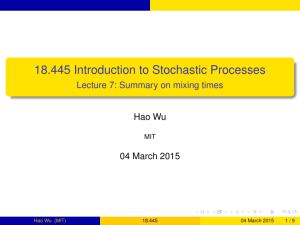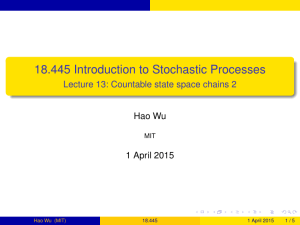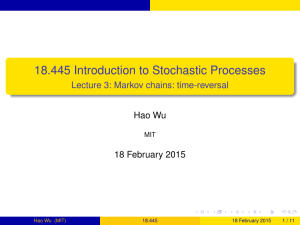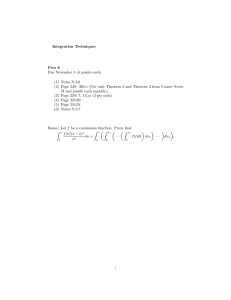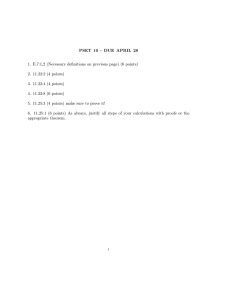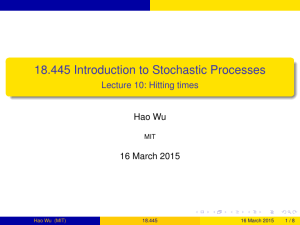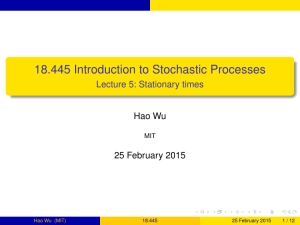18.445 Introduction to Stochastic Processes Hao Wu 23 February 2015
advertisement
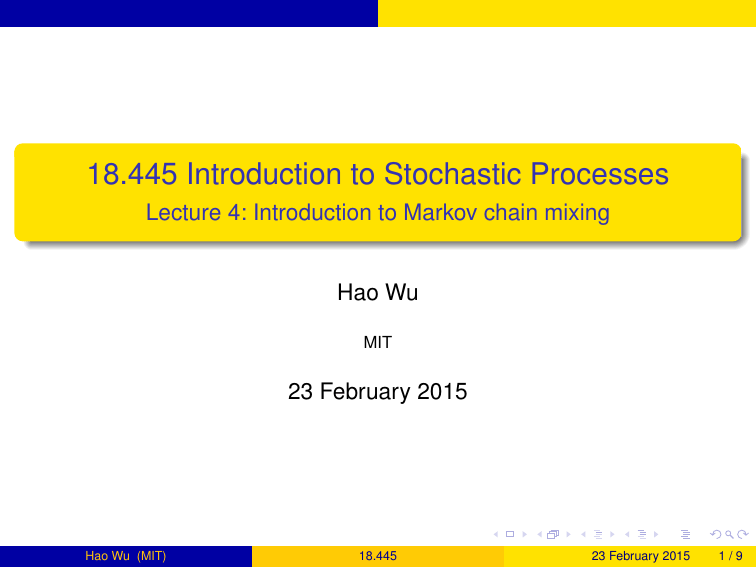
18.445 Introduction to Stochastic Processes
Lecture 4: Introduction to Markov chain mixing
Hao Wu
MIT
23 February 2015
Hao Wu (MIT)
18.445
23 February 2015
1/9
Announcement
Midterm : April 6th.(on class)
Final : May 18th.
The tests are closed book, closed notes, no calculators.
Recall
If (Xn )n is an irreducible Markov chain with stationary distribution π,
then
n
1n
lim
1[Xj =x] = π(x), Pµ − a.s.
n→∞ n
j=0
Today’s goal We will show that Xn converges to π under some "strong
sense".
total variation distance
the convergence theorem
mixing times
Hao Wu (MIT)
18.445
23 February 2015
2/9
Three ways to characterize the total variation distance
µ and ν : probability measures on Ω.
||µ − ν||TV = max |µ(A) − ν(A)|.
A⊂Ω
Lemma
||µ − ν||TV =
1X
|µ(x) − ν(x)|.
2
x∈Ω
||µ − ν||TV =
1
sup{µf − νf : f satisfying max |f (x)| ≤ 1}.
x∈Ω
2
||µ − ν||TV = inf{P[X 6= Y ] : (X , Y ) is a coupling of µ, ν}.
Definition
We call (X , Y ) the optimal coupling if P[X 6= Y ] = ||µ − ν||TV .
Hao Wu (MIT)
18.445
23 February 2015
3/9
The Convergence Theorem
Suppose that (Xn )n is a Markov chain with transition matrix P. Assume
that P is irreducible and aperiodic, then
there exists r such that P r (x, y ) > 0 for all x, y ∈ Ω ;
there exists a unique stationary distribution π and π(x) > 0 for all
x ∈ Ω.
Theorem
Suppose that P is irreducible, aperiodic, with stationary distribution π.
Then there exist constants α ∈ (0, 1) and C > 0 such that
max ||P n (x, ·) − π||TV ≤ C αn
x∈Ω
Hao Wu (MIT)
18.445
∀n ≥ 1.
23 February 2015
4/9
Mixing time
Definition
d(n) = max ||P n (x, ·) − π||TV
x∈Ω
d̄(n) = max ||P n (x, ·) − P n (y , ·)||TV
x,y ∈Ω
Lemma
d(n) ≤ d̄(n) ≤ 2d(n)
Lemma
d̄(m + n) ≤ d̄(m) · d̄(n)
Corollary
d̄(mn) ≤ d̄(n)m
Hao Wu (MIT)
18.445
23 February 2015
5/9
Mixing time
Definition
tmix = min{n : d(n) ≤ 1/4},
tmix () = min{n : d(n) ≤ }
Lemma
1 tmix
tmix () ≤ log( )
log 2
Questions : How long does it take the Markov chain to be close to the
stationary measure ?
Lecture 5 : Upper bounds on tmix ; Lecture 6 : Lower bounds on tmix ;
Lecture 7 : Interesting models.
Hao Wu (MIT)
18.445
23 February 2015
6/9
Couple two Markov chains
Definition
A coupling of two Markov chains with transition matrix P is a process
(Xn , Yn )n≥0 with the following two properties.
Both (Xn ) and (Yn ) are Markov chains with transition matrix P.
They stay together after their first meet.
Notation : If (Xn )n≥0 and (Yn )n≥0 are coupled Markov chains with
X0 = x, Y0 = y , then we denote by Px,y the law of (Xn , Yn )n≥0 .
Hao Wu (MIT)
18.445
23 February 2015
7/9
Couple two Markov chains
Theorem
Suppose that P is irreducible with stationary distribution π. Let
(Xn , Yn )n≥0 be a coupling of Markov chains with transition matrix P for
which X0 = x, Y0 = y . Define τ to be their first meet time :
τ = min{n ≥ 0 : Xn = Yn }.
Then
||P n (x, ·) − P n (y , ·)||TV ≤ Px,y [τ > n].
In particular,
d(n) ≤ max Px,y [τ > n].
x,y
Hao Wu (MIT)
18.445
23 February 2015
8/9
Random walk on N−cycle : Upper bound on tmix
Lazy walk : it remains in current position with probability 1/2, moves
left with probability 1/4, right with probability 1/4.
It is irreducible.
The stationary measure is the uniform measure.
Theorem
For the lazy walk on N−cycle, we have
tmix ≤ N 2 .
Hao Wu (MIT)
18.445
23 February 2015
9/9
MIT OpenCourseWare
http://ocw.mit.edu
18.445 Introduction to Stochastic Processes
Spring 2015
For information about citing these materials or our Terms of Use, visit: http://ocw.mit.edu/terms.
